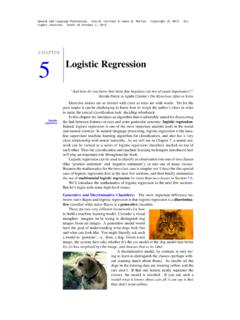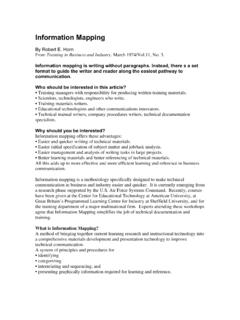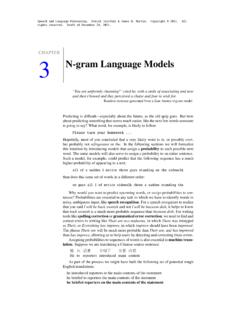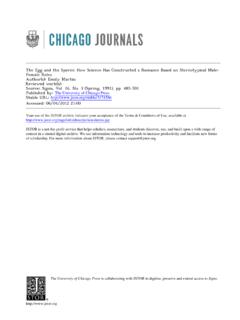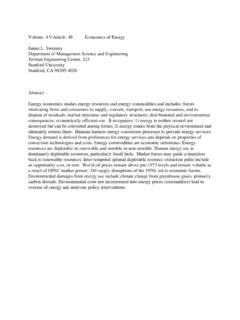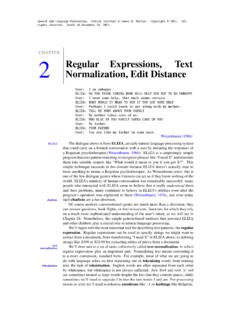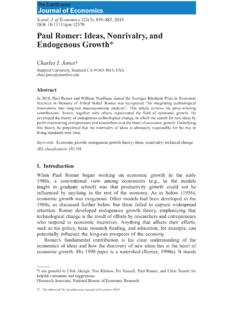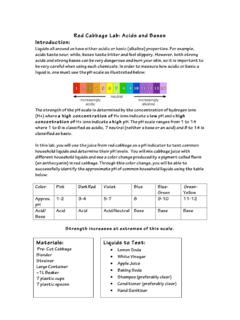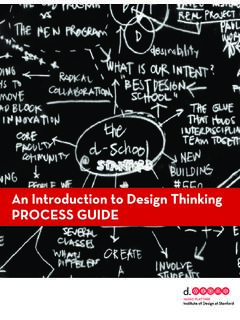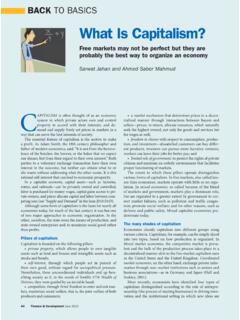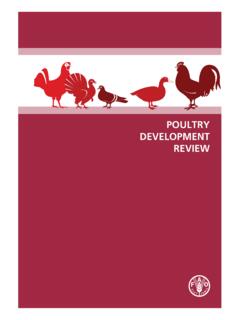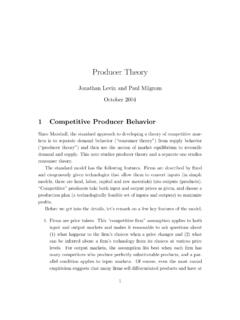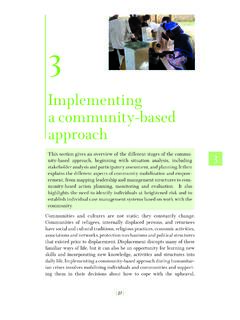Transcription of Endogenous Technological Change Paul M. Romer The …
1 Endogenous Technological ChangePaul M. RomerThe Journal of Political Economy, Vol. 98, No. 5, Part 2: The Problem of Development: AConference of the Institute for the Study of Free Enterprise Systems. (Oct., 1990), pp. URL: Journal of Political Economyis currently published by The University of Chicago use of the JSTOR archive indicates your acceptance of JSTOR's Terms and Conditions of Use, available JSTOR's Terms and Conditions of Use provides, in part, that unless you have obtainedprior permission, you may not download an entire issue of a journal or multiple copies of articles, and you may use content inthe JSTOR archive only for your personal, non-commercial contact the publisher regarding any further use of this work.
2 Publisher contact information may be obtained copy of any part of a JSTOR transmission must contain the same copyright notice that appears on the screen or printedpage of such JSTOR Archive is a trusted digital repository providing for long-term preservation and access to leading academicjournals and scholarly literature from around the world. The Archive is supported by libraries, scholarly societies, publishers,and foundations. It is an initiative of JSTOR, a not-for-profit organization with a mission to help the scholarly community takeadvantage of advances in technology. For more information regarding JSTOR, please contact Jan 9 14:30:43 2008 Endogenous Technological Change Paul M. Romer Unluerszty of Ch~cago Growth in this model is driven by Technological Change that arises from intentional investment decisions made by profit-maximizing agents.
3 The distinguishing feature of the technology as an input is that it is neither a conventional good nor a public good; it is a non- rival, partially excludable good. Because of the nonconvexity in- troduced by a nonrival good, price-taking competition cannot be supported. Instead, the equilibrium is one with monopolistic compe- tition. The main conclusions are that the stock of human capital determines the rate of growth, that too little human capital is de- voted to research in equilibrium, that integration into world markets will increase growth rates, and that having a large population is not sufficient to generate growth. I. Introduction Output per hour worked in the United States today is 10 times as valuable as output per hour worked 100 years ago (Maddison 1982).
4 In the 1950s, economists attributed almost all the Change in output per hour worked to Technological Change (Abramovitz 1956; Ken- drick 1956; Solow 1957). Subsequent analysis raised our estimates of Prepared for the conference "The Problem of Economic Development: Exploring Economic Development through Free Enterprise," held at the State University of New York at Buffalo, May 1988. I have benefited from the comments of many seminar and conference participants and two discussants (Rob Vishny, Buffalo, May 1988, and Dale Jorgenson, National Bureau of Economic Research Economic Fluctuations meeting, July 1988). Discussions with Gary Becker, Karl Shell, Robert Lucas, Gene Grossman, and Elhanan Helpman were especially helpfill.
5 Research assistance was provided by Danyang Xie. The original work was supported by National Science Foundation grant SES-8618325. It was revised while I was a visitor at the Center for Advanced Study in the Behavioral Sciences and supported by NSF grant BNS87-00864. [Juuninl ?/ Po/ili,ni Econuniv, 1990, \ol. $ , 5, pt. 21 Q 1990 hr l'hr L'nlverslty of Chic,igo. All lights reseried 0022-3808190198O5-0~115$~11.~0 S72 JOURNAL OF POLITICAL ECONOMY the importance of increases in the effective labor force and the effec- tive stock of capital in generating growth in output per worker (Jor- genson, Gollop, and Fraumeni 1987), but Technological Change has surely been important as well. The raw materials that we use have not changed, but as a result of trial and error, experimentation, refine- ment, and scientific investigation, the instructions that we follow for combining raw materials have become vastly more sophisticated.]
6 One hundred years ago, all we could do to get visual stimulation from iron oxide was to use it as a pigment. Now we put it on plastic tape and use it to make videocassette recordings. The argument presented in this paper is based on three premises. The first is that Technological Change -improvement in the instruc- tions for mixing together raw materials-lies at the heart of economic growth. As a result, the model presented here resembles the Solow (1956) model with Technological Change . Technological Change pro- vides the incentive for continued capital accumulation, and together, capital accumulation and Technological Change account for much of the increase in output per hour worked. The second premise is that Technological Change arises in large part because of intentional actions taken by people who respond to market incentives.
7 Thus the model is one of Endogenous rather than exoge- nous Technological Change . This does not mean that everyone who contributes to Technological Change is motivated by market incentives. An academic scientist who is supported by government grants may be totally insulated from them. The premise here is that market incen- tives nonetheless play an essential role in the process whereby new knowledge is translated into goods with practical value. Our initial understanding of electromagnetism arose from research conducted in academic institutions, but magnetic tape and home videocassette recorders resulted from attempts by private firms to earn a profit. The third and most fundamental premise is that instructions for working with raw materials are inherently different from other eco- nomic goods.
8 Once the cost of creating a new set of instructions has been incurred, the instructions can be used over and over again at no additional cost. Developing new and better instructions is equivalent to incurring a fixed cost. This property is taken to be the defining characteristic of technology. Most models of aggregate growth, even those with spillovers or external effects, rely on price-taking behavior. But once these three premises are granted, it follows directly that an equilibrium with price taking cannot be supported. Section I1 of the paper starts by showing why this is so. It also indicates which of the premises is dropped in growth models that do depend on price-taking behavior. The argu- ment in this section is fundamental to the motivation for the particu- Technological Change S73 lar model of monopolistic competition that follows, but it is more general than the model itself.
9 In the specific model outlined in Section 111, a firm incurs fixed design or research and development costs when it creates a new good. It recovers those costs by selling the new good for a price that is higher than its constant cost of production. Since there is free entry into this activity, firms earn zero profit in a present value sense. The conclusions of the model follow directly from this specification. On the basis of results from the static theory of trade with differ- entiated goods (see, , Helpman and Krugman 1985),one should expect that fixed costs lead to gains from increases in the size of the market and therefore to gains from trade between different coun- tries. Perhaps the most interesting feature of the equilibrium cal- culated for the model constructed here is that increases in the size of the market have effects not only on the level of income and welfare but also on the rate of growth.
10 Larger markets induce more research and faster growth. The analysis also suggests why population is not the right measure of market size and why the presence of a large domestic market in countries such as China or India is not a substitute for trade with the rest of the world. The growth rate is increasing in the stock of human capital, but it does not depend on the total size of the labor force or the population. In a limiting case that may be relevant for historical analysis and for the poorest countries today, if the stock of human capital is too low, growth may not take place at all. These implications of the model are taken up briefly in the final sections of the paper. Section I11 describes the functional forms that are used to describe the preferences and the technology for the model.
